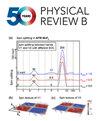(C5H9NH3)2CuBr4: A metal-organic two-ladder quantum magnet
IF 3.7
2区 物理与天体物理
Q1 Physics and Astronomy
引用次数: 0
Abstract
Low-dimensional quantum magnets are a versatile materials platform for studying the emergent many-body physics and collective excitations that can arise even in systems with only short-range interactions. Understanding their low-temperature structure and spin Hamiltonian is key to explaining their magnetic properties, including unconventional quantum phases, phase transitions, and excited states. We study the metal-organic coordination compound and its deuterated counterpart, which upon its discovery was identified as a candidate two-leg quantum spin ladder in the strong-leg coupling regime. By growing large single crystals and probing them with both bulk and microscopic techniques, we deduce that two previously unknown structural phase transitions take place between 136 and 113 K. The low-temperature structure has a monoclinic unit cell that gives rise to two inequivalent spin ladders. We further confirm the absence of long-range magnetic order down to 30 mK and investigate the implications of this two-ladder structure for the magnetic properties of by analyzing our own specific-heat and susceptibility data.

(C5H9NH3)2CuBr4:一种金属有机双梯量子磁体
低维量子磁体是研究新兴多体物理和集体激发的多功能材料平台,即使在只有短程相互作用的系统中也会出现这种现象。了解它们的低温结构和自旋哈密顿是解释其磁性能(包括非常规量子相、相变和激发态)的关键。我们研究了金属有机配位化合物 (C5H9NH3)2CuBr4 及其氚化对应物,该化合物一经发现就被确定为强腿耦合机制中的候选两腿量子(S=12)自旋阶梯。通过培育大型单晶体,并利用块体和显微技术对其进行探测,我们推断出在 136 至 113 K 之间发生了两种之前未知的结构相变。我们进一步证实在低至 30 mK 的温度下不存在长程磁序,并通过分析我们自己的比热和磁感应强度数据,研究了这种双阶梯结构对 (C5H9NH3)2CuBr4 磁特性的影响。
本文章由计算机程序翻译,如有差异,请以英文原文为准。
求助全文
约1分钟内获得全文
求助全文
来源期刊

Physical Review B
物理-物理:凝聚态物理
CiteScore
6.70
自引率
32.40%
发文量
0
审稿时长
3.0 months
期刊介绍:
Physical Review B (PRB) is the world’s largest dedicated physics journal, publishing approximately 100 new, high-quality papers each week. The most highly cited journal in condensed matter physics, PRB provides outstanding depth and breadth of coverage, combined with unrivaled context and background for ongoing research by scientists worldwide.
PRB covers the full range of condensed matter, materials physics, and related subfields, including:
-Structure and phase transitions
-Ferroelectrics and multiferroics
-Disordered systems and alloys
-Magnetism
-Superconductivity
-Electronic structure, photonics, and metamaterials
-Semiconductors and mesoscopic systems
-Surfaces, nanoscience, and two-dimensional materials
-Topological states of matter
 求助内容:
求助内容: 应助结果提醒方式:
应助结果提醒方式:


